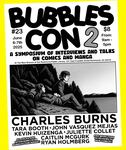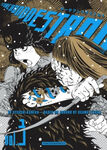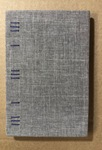
OUT OF STOCK!
OK kids, the wait is over. This mega-blast of comics and more by Fort Thunder co-founder Brian Chippendale is now on our shelves, and it's most definititely a book that stands out in a crowd. Five years in the making, it's Chippendale's first book publication, and he's gone all out to make it a debut to remember. It's a giant oversize (11" x 17") 144 page hardcover volume printed in black and white and full color where it counts. 80 pages are devoted to the titular graphic novel that is both an epic -- and deranged -- fantasy and an urban allegory. The remaining 64 pages are chock-a-block with drawings, collages, posters and more. While much is simply pen and ink and/or pencil, this is reproduced with full attention to all details and subtleties. Ninja is a sensual onslaught that staggers the reader's brain as it tries to take it all in. We found ourselves going back again and again to soak up the richness of its imagery while simultaneously working to crack the riddles of its narratives.
This book is bursting with energy. A frantic childlike mania inhabits many of its crowded, dense pages. A big factor in this is, in all probablity, the fact that Ninja was actually begun by Chippendale when he was eleven years old and then picked up and continued roughly eighteen years later, after having matured as an artist. Chippendale maintains the same crowded, gutterless panel structure that he inititated a child, while filling it with a fully developed, unified artistic vision. While the initial per-page panel count of the work he produced as a child varied, the bulk of the adult pages adhere to a 25 panel per page grid, with two drawn pages printed one above the other, making for brain-frying double page spreads containing exactly 100 panels; although this begins to vary and change quite a bit towards the last third of the piece.
There is so much crammed into each double-page spread -- in the drawings as well as the narrative -- that its difficult not to feel overwhelmed each time the page is turned; but the underlying propulsive energy of the artwork powers the reader onward. The first thing the reader registers upon turning each page is texture. Only upon focusing the eyes and beginning the reading process -- following Chippendale's unique back and forth snaking drawing directions -- do the details begin to emerge and the story take shape. And then there's the characters themselves. Taking the catalogue of types that he developed as a child, Chippendale morphs them into a rag tag assemblage of truly strange ideograms representing the shocked sense of outrage at the experiences his innocence has suffered. Only the ninja him(it?)self remains essentially the same enigmatic icon of justice.
A visual and reading experience like none other, Ninja is a work that cannot be ignored. Published by the design wizards at Picture Box.




















